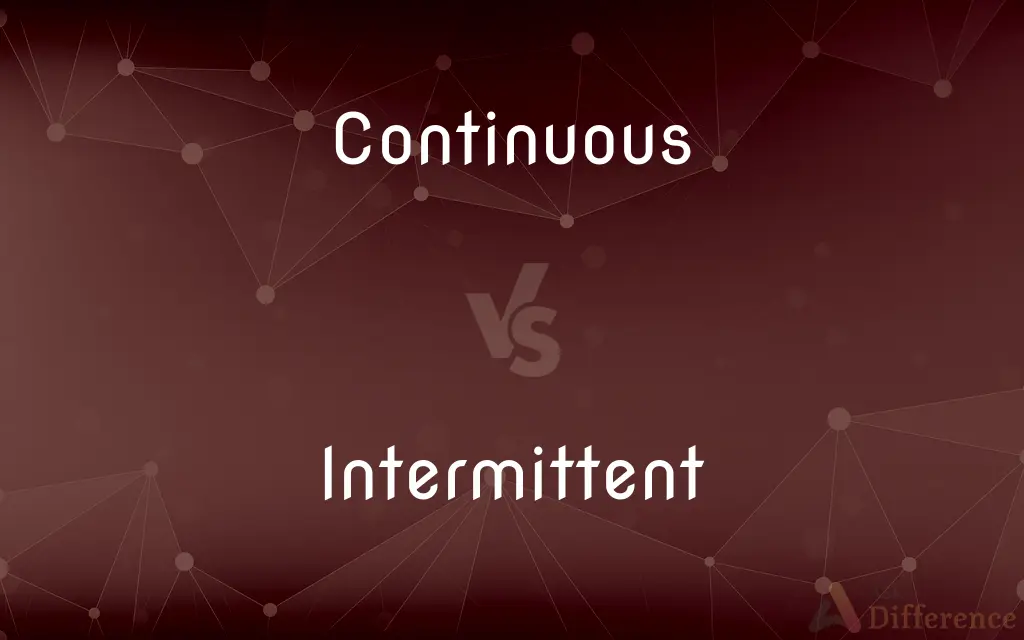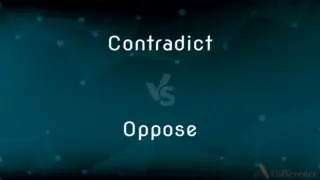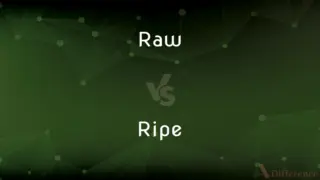Continuous vs. Intermittent — What's the Difference?
By Maham Liaqat & Fiza Rafique — Updated on March 28, 2024
Continuous refers to actions or processes that occur without interruption, whereas intermittent describes events or activities that start and stop at intervals.

Difference Between Continuous and Intermittent
Table of Contents
ADVERTISEMENT
Key Differences
Continuous activities or processes proceed uninterrupted for a period of time, showcasing a consistent and unbroken flow. This concept is often applied in contexts like continuous data streams in computing or continuous production in manufacturing, emphasizing the lack of breaks or interruptions. On the other hand, intermittent events or activities are characterized by their start-stop nature, occurring at irregular or regular intervals but not constantly. This is visible in scenarios like intermittent fasting in health or intermittent rainfall in weather, where the activity or condition pauses and resumes over time.
The continuous approach is often preferred in processes that require a steady output or consistent monitoring, as it ensures a constant flow of work, energy, or information. Continuous operations are key in industries such as chemical processing or energy production, where a halt in processes could lead to inefficiency or safety risks. In contrast, intermittent methods are useful in situations where breaks are necessary or beneficial for the system’s efficiency or recovery, such as intermittent charging of batteries to extend their lifespan or intermittent exercise schedules for better health outcomes.
In the realm of data, continuous data can assume any value within a given range, offering a smooth and unbroken dataset. This contrasts with intermittent data, which might represent discrete events or conditions occurring at specific times, leading to datasets with gaps or breaks. The choice between continuous and intermittent strategies or observations often depends on the nature of the phenomenon being studied or the objectives of a project, highlighting the importance of context in determining the most effective approach.
While continuous processes aim for uniformity and steadiness, making them ideal for scenarios requiring constant attention or output, intermittent processes offer flexibility and adaptability, allowing systems or individuals to operate efficiently under conditions that do not require or cannot sustain constant activity. This distinction underlines the strategic differences in approach across various fields, from engineering and science to health and environmental management.
Comparison Chart
Definition
Occurring without interruption or pause.
Occurring at irregular or regular intervals; not constant.
ADVERTISEMENT
Key Characteristics
Steady, unbroken flow or process.
Start-stop nature; pauses and resumes.
Applications
Continuous production, continuous data streaming.
Intermittent fasting, intermittent rainfall.
Preferred Contexts
Industries where constant operation is crucial.
Situations where breaks enhance efficiency or recovery.
Data Representation
Can assume any value within a range; smooth datasets.
Represents discrete events; datasets with gaps.
Compare with Definitions
Continuous
Seamless and constant.
The stream provides a continuous flow of water.
Intermittent
Occurring at irregular intervals.
Intermittent rain made the hike more challenging.
Continuous
Without pauses or breaks.
Continuous monitoring is essential in critical care units.
Intermittent
Alternating between pauses and activity.
Intermittent fasting involves cycles of eating and fasting.
Continuous
Always ongoing.
Continuous improvement is key to success in business.
Intermittent
Having breaks between occurrences.
The city experienced intermittent power outages.
Continuous
Uninterrupted in time.
The factory maintained continuous production to meet the high demand.
Intermittent
Periodic or sporadic.
She suffered from intermittent headaches.
Continuous
In mathematics, a continuous function has no breaks in its graph.
The temperature varied in a continuous manner throughout the day.
Intermittent
Not continuous or steady.
He experienced intermittent internet connectivity.
Continuous
Uninterrupted in time, sequence, substance, or extent.
Intermittent
Occurring at irregular intervals; not continuous or steady
Intermittent rain
Continuous
Attached together in repeated units
A continuous form fed into a printer.
Intermittent
Stopping and starting at intervals.
Continuous
Of or relating to a line or curve that extends without a break or irregularity.
Intermittent
Alternately containing and empty of water
An intermittent lake.
Continuous
Of or relating to a function between two topological spaces such that the preimage of any open set in the range is an open set in the domain.
Intermittent
Stopping and starting, occurring, or presenting at intervals; coming after a particular time span.
The day was cloudy with intermittent rain.
Intermittent bugs are most difficult to reproduce.
Continuous
Without stopping; without a break, cessation, or interruption.
A continuous current of electricity
Intermittent
Existing only for certain seasons; that is, being dry for part of the year.
The area has many intermittent lakes and streams.
Continuous
Without intervening space; continued.
A continuous line of railroad
Intermittent
An intermittent fever or disease.
Continuous
(botany) Not deviating or varying from uniformity; not interrupted; not joined or articulated.
Intermittent
Coming and going at intervals; alternating; recurrent; periodic; as, an intermittent fever.
Continuous
Such that, for every x in the domain, for each small open interval D about f(x), there's an interval containing x whose image is in D.
Intermittent
An intermittent fever or disease.
Continuous
Such that each open set in the target space has an open preimage (in the domain space, with respect to the given function).
Each continuous function from the real line to the rationals is constant, since the rationals are totally disconnected.
Intermittent
Stopping and starting at irregular intervals;
Intermittent rain showers
Continuous
(grammar) Expressing an ongoing action or state.
Intermittent
Stopping and starting at regular intervals
Continuous
Without break, cessation, or interruption; without intervening space or time; uninterrupted; unbroken; continual; unceasing; constant; continued; protracted; extended; as, a continuous line of railroad; a continuous current of electricity.
He can hear its continuous murmur.
Continuous
Not deviating or varying from uninformity; not interrupted; not joined or articulated.
Continuous
Continuing in time or space without interruption;
A continuous rearrangement of electrons in the solar atoms results in the emission of light
A continuous bout of illness lasting six months
Lived in continuous fear
A continuous row of warehouses
A continuous line has no gaps or breaks in it
Moving midweek holidays to the nearest Monday or Friday allows uninterrupted work weeks
Continuous
Of a function or curve; extending without break or irregularity
Common Curiosities
What does continuous mean?
Continuous refers to something happening without any breaks or interruptions, ensuring a constant and steady flow or presence.
What is the meaning of intermittent?
Intermittent describes events or activities that stop and start again one or more times, not occurring in a constant or continuous manner.
When is an intermittent approach beneficial?
An intermittent approach is beneficial when breaks or pauses can lead to improved efficiency, recovery, or performance, such as in health regimens or technical systems.
Can something be both continuous and intermittent?
While something typically cannot be both continuous and intermittent in the same context, certain systems may have components that operate continuously and others that operate intermittently.
How do continuous and intermittent strategies impact efficiency?
Continuous strategies ensure steady productivity and efficiency in processes needing constant operation, whereas intermittent strategies can optimize efficiency by allowing rest periods or adjustments based on demand.
What role does technology play in managing continuous and intermittent processes?
Technology plays a crucial role in monitoring, controlling, and optimizing both continuous and intermittent processes, ensuring they meet their intended objectives efficiently.
How do continuous and intermittent strategies affect resource consumption?
Continuous strategies may lead to steady resource consumption, while intermittent strategies can reduce resource use during off-peak times or allow for recovery.
How do environmental conditions influence the choice between continuous and intermittent strategies?
Environmental conditions, such as temperature and humidity, can dictate whether continuous or intermittent strategies are more effective for processes like heating or cooling.
In what ways do continuous and intermittent feeding strategies differ in healthcare?
Continuous feeding involves a steady infusion of nutrients, beneficial for certain medical conditions, while intermittent feeding mimics normal eating patterns, allowing the digestive system to rest between feeds.
How does continuous data differ from intermittent data?
Continuous data can take any value within a range and is unbroken, whereas intermittent data represents discrete occurrences with gaps or breaks in the dataset.
Why choose a continuous process?
A continuous process is chosen for its efficiency, consistency, and the need for a steady output without interruptions, especially in industrial or monitoring applications.
Can the human body handle continuous activity?
The human body can handle certain continuous activities, like heart function, but most physical and cognitive activities require intermittent breaks for recovery and health.
What are examples of continuous and intermittent processes?
Continuous processes include constant electricity generation, while intermittent processes could be exemplified by cyclic loading and unloading in logistics.
What is the significance of continuity in electrical circuits?
In electrical circuits, continuity is crucial for the uninterrupted flow of electricity, ensuring devices operate properly without disruptions.
How do continuous and intermittent reinforcements differ in behavior modification?
In behavior modification, continuous reinforcement involves rewarding every desired behavior, while intermittent reinforcement rewards behaviors only some of the time, influencing the rate and strength of behavior acquisition.
Share Your Discovery

Previous Comparison
Contradict vs. Oppose
Next Comparison
Raw vs. RipeAuthor Spotlight
Written by
Maham LiaqatCo-written by
Fiza RafiqueFiza Rafique is a skilled content writer at AskDifference.com, where she meticulously refines and enhances written pieces. Drawing from her vast editorial expertise, Fiza ensures clarity, accuracy, and precision in every article. Passionate about language, she continually seeks to elevate the quality of content for readers worldwide.














































